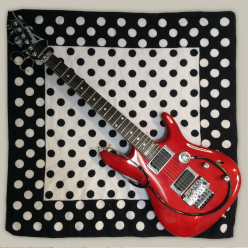The tempo of this track is 110.092 beats per minute (BPM). This could easily be a human heartbeat rate. However, anything above 100 BPM while resting is considered tachycardia for an adult - a pulse higher than normal. You'll notice the bass and kick drum occasionally double the tempo; this is also a typical symptom when the pulse suddenly jumps to a fast rate for a while. It's by and large a benign condition, and certainly one of the main sources of inspiration here.
Organic growth
Musically speaking, this started with a small idea around three notes played by the bass. It was like the seed from which everything else would grow. A new instrument would be added, then I would go back to adjust the drum samples or the bass, and record another part again... Eventually the same approach was used with the drums, bass, guitar, synthesizer keyboard and trumpet. The structure or "sequence" also kept evolving until fairly late as part of the whole process, adding extra chords and a bridge section in a foreign key. By the time I reached the current version, after 25 intermediate steps, every single sound had probably been recorded or generated from scratch two or three times. This felt a bit like nurturing a growing organism which was creating new cells and replacing old ones. It now appears to be big enough to get released to the world.
Nerd's corner
The drums were generated using samples imported from Hydrogen's UltraAcousticKit and sequenced using Splat, which is also used to generate the bass. The full source code and edited samples are available on GitLab. An electric bass is also played to complete the sound, mostly in unison with a few runs. Then the guitar (as seen in the picture), synth keyboard and trumpet were recorded on top of it.
The bass theme is E, E, F, Eb played in a loop. This then leads to a basic harmonic progression around two chords: Em (E, E) and F7 (F, Eb). The sequence is entirely based on sections of six bars, initially Em | F7 repeated three times. Some variants are used to initiate transitions with other instruments using two additional chords: G | F#dim F7. The bridge starts with a diversion hinging on the F7 chord, with a ninth becoming minor (G to Gb) to then land in Bbm. The reverse occurs at the end of the bridge, back with a major ninth on F7 as a substitute to B7 in order to return to the original key of Em.


